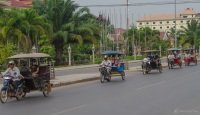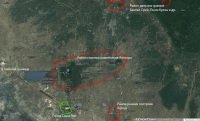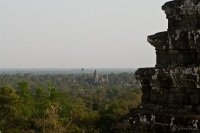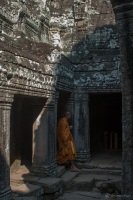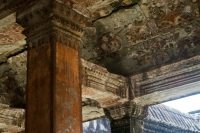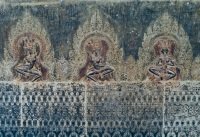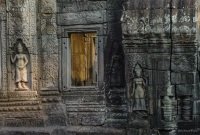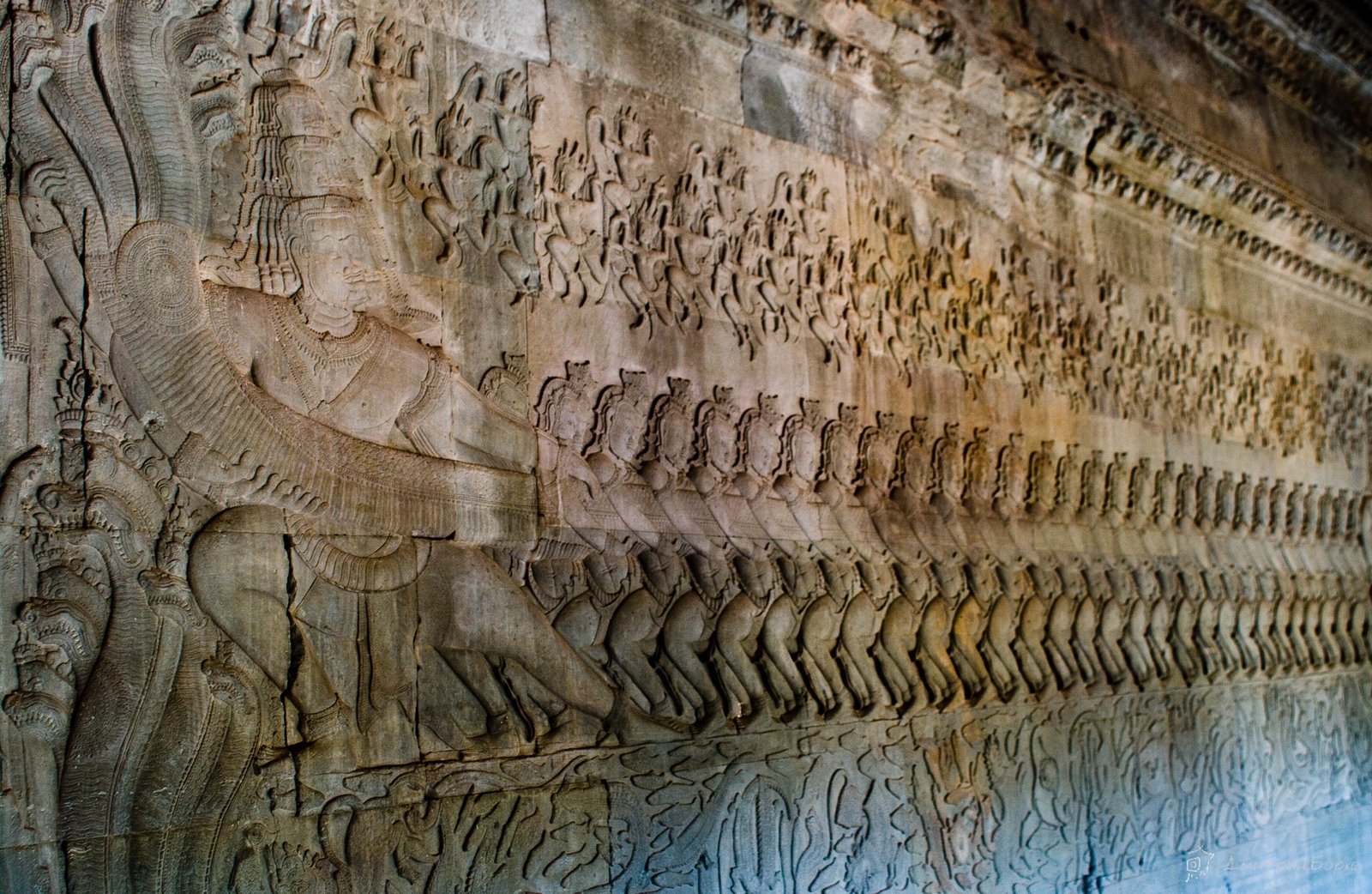Angkor didn’t work at all. The method of acquaintance “with a swoop” did not work. Lacked knowledge. Several flash drives with photos burned down. Having reached the Internet, they began to dig for information, but everything Russian-speaking turned out to be either empty-mouthed advertising, or Ufology and scientific Fomenkovism. And there was no time and effort to enter complex English-language archaeological texts.
We expected revelations and impressions from Angkor. And it turned out to be a business venture with tuktuks, dusty heat, long dirt roads through the forest and jumping over potholes in a tarantike with no suspension. Impressions were drowned in attempts to go around and climb all these monotonous, almost lost outlines and completely alien to the soul, stone ruins, surrounded by thousands of tourists, begging children and food vendors demanding seven times the price for a bottle of water.
However, on the third day something suddenly changed. The red forest roads entered into harmony with the forest greenery, the complexes located a little away from the tourist trails turned out to be almost deserted, and, as it happened more than once, curiosity woke up in us and questions arose. Driving for the fifth time past the most eminent Angkor Wat, we suddenly found it austere and majestic. From the guide it turned out that when we entered it on the first day, we did not even see half of its amazing bas-reliefs.
Walking around the city, I looked into a small school museum, where only a few phrases about the history of Angkor and hand-drawn illustrations were written in English, and I had an epiphany. It turned out that his head is enough to see something. And when your own guesses are confirmed, it’s much more fun than ready-made fast food!
Reference. Angkor is a complex of buildings left from several capital cities during the heyday of the ancient Khmer state, 8-12 centuries.
We didn’t expect it to be THIS big! Angkor is not a temple or a palace, but a space of about 15×40 km. Each temple in itself is no less than the Kremlin. We never made it to some places. From Borobudur or Prambanan impressions rolled instantly. Angkor is not immediately visible to the eye. The first impression of monotony is partly explained by the huge number of surviving buildings: in Moscow, too, at first glance, all houses are the same – made of brick and under a roof. And I have already written about the second reason.
All that has been preserved here is artificial reservoirs, city walls and temple complexes. Once upon a time, vast settlements stretched around (according to some versions, from 500,000 to a million people lived here), but all residential buildings were wooden. Apparently, even royal palaces. There was no trace left of them.
The first thing that catches your eye is the water surrounding the temples. The artificial reservoir in the photo (barai) is not the largest, 800 meters in length.
The second is ancient roads. Wide, lined with mighty slabs – tanks could drive along them.
And temples, consisting mainly of towers (prasats) and their surrounding galleries. The architecture is incredibly heavy, squat, solid stone mass presses down to the ground. There is no dynamics in the figures of stone warriors guarding the approaches to the gates, pedestal legs, square jaws, the corners of heavy lips lowered down, narrow slits of the eyes. What is behind this power?
The god-king and the arrangement of Angkorian temples
In the 9th century, King Jayavarman II invented the religion with which the Khmer empire flourished and lived for nearly 600 years. Of course, the Khmer had a religion before – Hinduism came here long before that. Yes, and the state has already existed for a long time, but by this time it was pretty rotten and crumbled, getting into dependence on its neighbors in its various parts. So Jayavarman II had to reassemble and modernize it. In addition, although he was of royal blood, he was not completely pure, and he spent his youth at the court of the Javanese rulers, and came to his homeland as the local governor of one of the vassal provinces to Java. And so, in order to get rid of the overlord, to gain legitimacy from his own and revive the empire, he composed a new ideology.
According to historians, he carefully studied Indian beliefs and social structure. One thing he definitely did not like: that the Brahmins there are independent of the state. And then he himself became the king-god – Deva-raja. He successfully crossed Indian philosophy with a local legend about an Indian prince who came here and found Cambodia as a solid sea, led by the snake king Nag. Nag liked the brave and sad wanderer prince (otherwise he would have eaten), he gave his daughter for him, creating land for them in the middle of the sea (to live and rule). The story and characters fit perfectly into the Indian tradition. But the Cambodians themselves of that time were traditionally divided into “people of the earth” (northern plains and mountains) and “people of the water” (seaside and river south).
On the bas-relief of Angkor Wat is a legend about the churning of the milky ocean. The gods and asuras wrapped the Naga around Mount Meru and untwisted it, pulling its ends.
snake in an attempt to get the drink of immortality amrita. A lot of things stood out as a result – good and not so good
In general, everything formed, it remains only to indicate that the prince from the legend was the son of the Vedic god Indra. One of the oldest and main gods of many religions, Indra reigned in his paradise on Mount Meru, towering in the middle of the milky ocean (by the way, Indra defeated the snake-like god Vritra, who “fettered the rivers”). A few lucky ones were brought to the mountain by birds-Garuda. And the main food of Garuda was the snakes of doubt, living in the heads of unbelievers. Water is the embodiment of chaos. And at the same time – the main value for arid Cambodia. Water is commanded by snakes-nagas. In the middle of the water is a land-mountain, on which the god-Deva-raja, a descendant of Indra, sits. He is the Cambodian king! With the help of Garuda, he subjugates the nagas, who embody water. At the same time, water is a feminine symbol. And the symbol of the Deva Raja is the linga. The raja-maiden “has” the surrounding water in every sense: legally (like a king) owns all the water of the state and sexually – fertilizes it, giving birth to the country, its wealth and subjects.
Everything is very rational, no unnecessary images. Unless, angels-devatas, guards – dvarapalas and spirits of water and air – Apsara dancers. The latter are necessary for the numerous rites of glorification of the virtues of the Borg King Deva Raja. mythical and real. After all, the religion of the god-king regulated only the relationship between man and the state. The subjects were called upon in endless rituals and dances (Apsaras!) to glorify him. But their personal relationship with the gods was not affected by the cult of the Deva Raja. And they were free to practice ancient animism, and all forms of Hinduism, and later – Buddhism. Even the Indian caste was not useful to this system. By the way, when Buddhism was finally established in Cambodia, Deva Raja smoothly turned into Budha Raja!
It only remained to consolidate the idea in visual agitation. And every king after Jayavarman II built for himself a temple-mountain-Meru with a linga in the upper tower. The temple is surrounded by a vast moat or stands on the bank of a barai – a huge artificial reservoir. Until now, it is not known exactly what was more important in the construction of these giant lakes (up to several kilometers long): they were a pure symbol or a serious irrigation system. Most likely, it’s both. Because in Cambodia of those times, it seems that the myth turned into reality and was confirmed by it. We saw in today’s Cambodia tiny little ponds – “huts” at each village house – to collect and save water for a dry period. And the king had to have a lot of water – all that is!
Temples are repeated with the same details. Their boringly absolute symmetry emphasizes absolute centralism and order.
Reference: “The Temple of Ta Prohm was served by 18 main clergy and 2740 minor ones. Plus priests of the highest caste, who were “out of state” due to their exceptional position: bhagavans (“reverend”), salaidhipah (“head of the mountain”), hotars who performed sacrifices , astrologers responsible for setting the time for ceremonies, etc. For each of the priests and higher servants, there were several dozen servants, including people who performed vital functions: umbrella bearers, garland weavers, spice and incense grinders, dancers, singers, etc. “In addition, thousands of temple-owned peasants worked in the rice fields as slaves or semi-dependents. In total, Ta Prohm was served by 79,365 people.”
The empire was powerful, what can I say! We would have died long ago at such expenses! But in addition to all this garbage, there is beauty in the Angkor monuments, and the flight of the spirit of artists. No one can deal with this!

